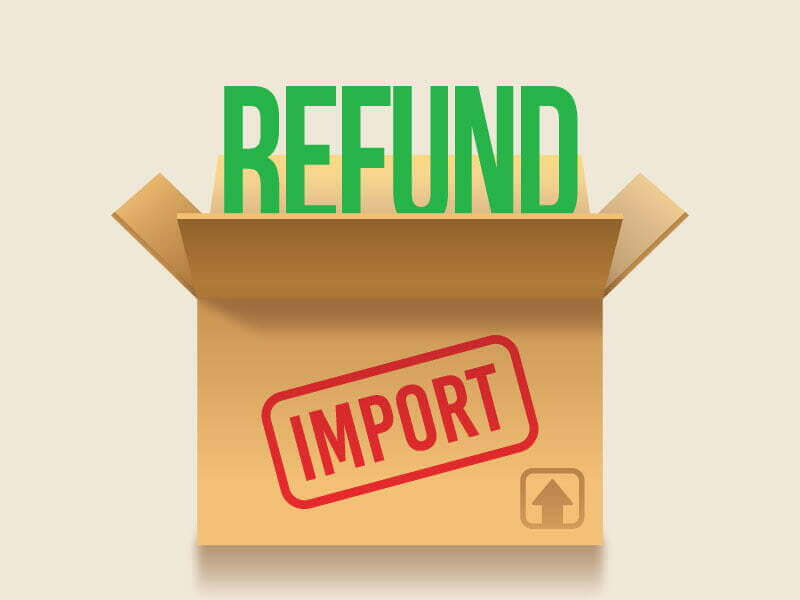
Depending on the goods you import and what you ultimately do with them, you may qualify for a duty drawback from Customs and Border Protection (CBP). Duty drawbacks can help you recoup losses and shore up your bottom line. Applying for a drawback, however, is no simple task.
Key Takeaways
Read more below to learn about duty drawbacks and how a customs broker can help you get the maximum refund available to you.
A duty drawback is a refund issued by Customs and Border Protection (CBP) on duties, taxes, or fees previously collected during the importation of goods.
Goods imported to the United States that are exported back out or destroyed can qualify for duty refunds up to 99% if the appropriate paperwork is kept and submitted. This includes CBP Form 7553.
The best comparison to this in everyday life is if you buy an item from a store, but then return it. You are refunded not only the item’s unit price, but also the sales tax you were assessed during the purchase. This is roughly how duty drawbacks work, although with a greater deal of complexity.
Related: What You Need to Know About Customs Duty Drawback
Let’s use a quick comparison to illustrate how much of an advantage your operations could gain from participating in the duty drawback program.
The base cost of an imported item for you and your competitor is $400. Both of you have to factor in a 25% duty ($100) and then mark the item up 50% ($200) to bring the total to $700 as the export selling price.
However, you participate in duty drawbacks and your competitor doesn’t. That means you are both selling your products for $700, but it costs you only $401 to fully export them, while your competitor must spend $500. You can lower your product’s price to $601, still realize your 50% markup, and severely undercut your competitor.

About $600 million is claimed in drawback per year. It is estimated that this is only 15% of available drawback funds, with 85% going unclaimed each year. Some of that money might be yours, and it’s time to learn how to get it.

Think you're owed money back on paid tariffs? Ask Our Experts.
Our 45 Minute Licensed Expert Consulting Will Personally Guide You.
The duty drawback program for earning back the money you’re entitled to can be pretty complex as far The key to success within the duty drawback program for earning back the money you’re entitled is making sure your information is extremely accurate.
To be in a position to make your claim, there are three items you must submit:
A Certificate of Delivery is a great document to keep and use for this purpose, since it can satisfy more than one of the requirements by itself. Another important thing to consider is that drawbacks can be claimed up to five years from the date that the goods were originally imported.
There are only four drawback center locations in all of America: they are in San Francisco, Houston, Chicago, and New York/Newark. Filing your drawback claim, however, is done electronically regardless of your location. This is best accomplished with help from a licensed customs broker.

While you might consider hiring a drawback broker is one more expense you could do without, there are a number of advantages that come with letting an expert handle this complex process. They include:

These, among other reasons, make it worthwhile to have a customs broker partner with you to apply for any drawbacks for which you might qualify. To further understand how a broker’s help can be invaluable, let’s take a look at the different types of drawback and how to file for them.
There are several scenarios in which you can claim duty drawback under 19 USC 1313, which deals with duty drawback and refunds. As mentioned in the previous section, you will need complete documentation as evidence that you’re complying with the guidelines of qualifying for a drawback.
Let’s take a closer look at some of the different duty drawbacks available to importers in the U.S.
Once products are exported or destroyed, the exporter can then file for duty drawback. This is the most straightforward method of qualifying that involves imported merchandise.
However, if the merchandise has been manipulated in any way — i.e. broken down into parts or similarly pieced out — the drawback will be drawn on each piece’s value at the time it was broken down. This is also known as manufacturing drawback.
You can still claim duty drawback on new items within five years of your initial purpose. However, in order to do this, the original products must be exported or destroyed. You must also be able to prove that the substituted items were similar enough to the original imports to warrant substitution during the construction or modification process.
If you receive items or components that are not up to your specifications, it can be sent back to the original importer within 5 years or destroyed.
Several goods and products related to food, drinks, medicine or toilet-related products are covered under the drawback and refund program.
These include salt for curing meat and fish. If salt is imported and then used to cure meat or fish that is either wild-caught or farmed, you can draw a refund on the tax originally paid for the salt.
This one is self-explanatory — if you import materials or equipment that are used to build vessels for any country outside of America, you can claim duty drawback on those materials.
If a jet engine is built, reconditioned, repaired or otherwise overhauled in the U.S. using foreign parts, then the duties charged can be recouped.
Sometimes materials or products are imported into the country with the full intention of being used. Should the items not be implemented into your original plans, you may be able to recoup some of your losses with an unused drawback.
This way, if you are still within a five-year period of the date of importation, you can file to have your paid duties refunded.
This is a crucial aspect for goods that aren’t destroyed prior to filing for drawback. It’s imperative the business claiming a drawback provides proof that the products have been exported out of the US.
This means that such documentation should firmly state the date, your identity as the exporter and the facts surrounding the exportation. These records will also greatly aid a duty drawback broker filing on your behalf.
When you’re ready to begin the process of initiating your rightful customs duty drawback, enlist the help of the experts at USA Custom Clearance. We can help in knowing the ins and outs of compiling the right paperwork, filling out the form and getting back any duty refunds you may be owed.
Additionally, we can assist your business with:
For a free quote today for any of our services or to specifically get started on your duty drawback request, call (866) 912-0406 or visit our customs consulting services page today!
 Copy URL to Clipboard
Copy URL to Clipboard
Add your first comment to this post